Blog
Seamanship
Simply British
If you’re old and travelled enough to remember British Seagull outboard motor's, you’ll appreciate this classic from Chris Caswell:
"Ornery Seagull outboards taught a generation never to get into a dinghy without oars"
/fl
Marine Safety
Deadly Fire Investigation
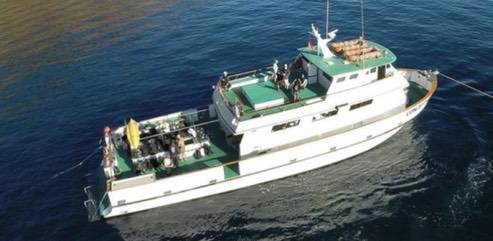
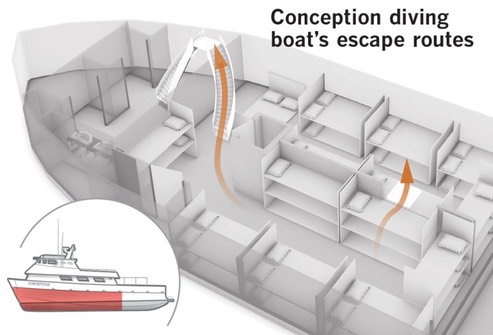
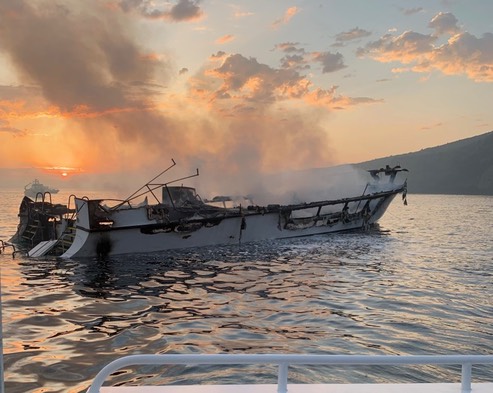
Statistics gathered by insurers and industry watchdogs show that about 55% of shipboard fires in smaller vessels are related to electrical systems….
“People have rechargeable everything these days,” said veteran diver Ben Wolfe, a retired Los Angeles County Fire Department captain who dived off the Conception two weeks before its fiery demise. “I had a battery like a TV camera battery that powered my underwater scooter plugged in each night.”
As a general rule, aside from a random smoking related fire, the most logical places for a catastrophic boat fire to begin are the engine room and the galley (which was evidently in the path of egress in this case.)
All of a boat's electrical circuits are protected by circuit breakers. But, those circuit breakers don’t offer any protection from faulty plug-in devices overheating.
There is a lot of concern, and speculation, regarding the cause of this fire, but the lack of a proper fire watch no-doubt led to the number of casualties.
Sad.
/fl
Seamanship
One Overlooked Detail
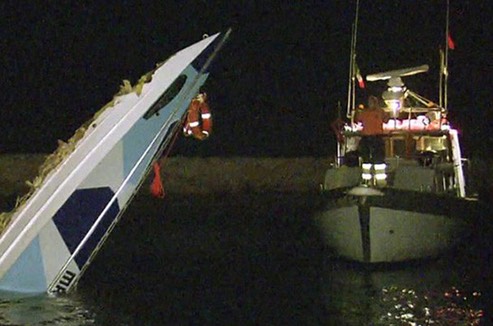
He was the ultimate professional, analysing every detail of the boat and the course as well as the opposition. No stone was left unturned in the quest for perfection and it was that same attention to detail that made such a success...
And yet, all it takes is one overlooked important detail! I’ll say it again; navigation waste is hazardous waste.
Fabio Buzzi and his crew were attempting to break the offshore speed record from Monte Carlo, and they were nearing the finish line when their power boat hit an artificial reef near the Italian city of Venice. Buzzi (76) and two other people died.
The lesson here is an important one!
The one great advantage that sailors have over “power boater’s” is that we have a little more time to correct our mistakes.
/fl
Marine Safety
Crew Asleep!
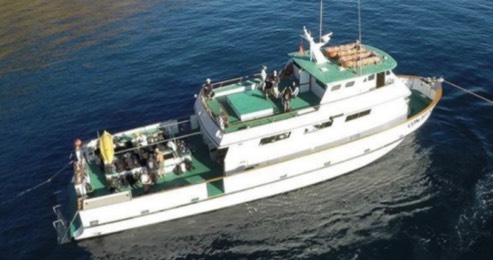
National Transportation Safety Board Preliminary Report: Marine DCA19MM047 (Reprinted below)
Executive Summary
The information in this preliminary report is subject to change and may contain errors. It will be supplemented or corrected during the course of the investigation.
"On Monday, September 2, 2019, about 3:14 a.m. Pacific daylight time, US Coast Guard Sector Los Angeles/Long Beach received a distress call from the 75-foot commercial diving vessel Conception, with 39 persons on board. The Conception was owned and operated by Truth Aquatics, Inc., based in Santa Barbara, California. The Conception was classified by the Coast Guard as a small passenger vessel that took passengers on dive excursions in the waters around the Channel Islands off the coast of Santa Barbara. The accident voyage was a three-day diving trip to the Channel Islands. On the last night of the voyage, the vessel was anchored in Platts Harbor off Santa Cruz Island, 21.5 nautical miles south-southwest of Santa Barbara, when it caught fire. Weather conditions were reported as slight to no winds with patchy fog, 2–3-foot seas, and air and water temperature about 65°F. The Conception was carrying 39 persons, 6 of which were crew. Thirty-three passengers and one crewmember died."
"The wood and fiberglass vessel was built in 1981. The vessel had three levels: the uppermost sun deck, containing the wheelhouse and crew rooms; the main deck, which included the salon and galley; and the lower deck within the hull, which housed the passenger berthing (bunkroom) and shower room, as well as the engine room and tanks."
"Initial interviews of three crewmembers revealed that no mechanical or electrical issues were reported. At the time of the fire, five crewmembers were asleep in berths behind the wheelhouse, and one crewmember was asleep in the bunkroom, which was accessed from the salon down a ladderwell in the forward, starboard corner of the compartment. The bunkroom had an emergency escape hatch located on the aft end, which also exited to the salon. There were two, locally-sounding smoke detectors in the overhead of the bunkroom."
"A crewmember sleeping in the wheelhouse berths was awakened by a noise and got up to investigate. He saw a fire at the aft end of the sun deck, rising up from the salon compartment below. The crewmember alerted the crew behind the wheelhouse. As crewmembers awoke, the captain radioed a distress message to the Coast Guard."
"The crewmembers attempted to access the salon and passengers below. Unable to use the aft ladder, which was on fire, the crewmembers jumped down to the main deck (one crewmember broke his leg in the process) and tried to access the salon and galley compartment, which was fully engulfed by fire at the aft end and by thick smoke in the forward end, through a forward window. Unable to open the window and overwhelmed by smoke, the crew jumped overboard."
"Two crewmembers and the captain swam to the stern, reboarded the vessel, opened the hatch to the engine room, and saw no fire. Access to the salon through the aft doors was blocked by fire, so they launched a small skiff and picked up the remaining two crewmembers in the water. They transferred to a recreational vessel anchored nearby (Grape Escape) where the captain continued to radio for help, while two crewmembers returned to the Conception to search for survivors around the burning hull. Local Coast Guard and fire departments arrived on scene to extinguish the fire and conduct search and rescue. The vessel burned to the waterline by morning and subsequently sank in about 60 feet of water."
"Later that day, the Coast Guard declared the accident a major marine casualty. The NTSB was named as the lead federal agency for the safety investigation and launched a full team to Santa Barbara, arriving on scene the following morning. The Coast Guard, Truth Aquatics, Inc., Santa Barbara County Sheriff’s Office, and Santa Barbara County Fire Department were named as parties to the NTSB investigation."
"Investigators have collected documents from recent Coast Guard inspections and visited another Truth Aquatics vessel, Vision, a vessel similar to the Conception. Salvage operations to bring the wreckage to the surface for examination and documentation have begun. Investigators plan to examine current regulations regarding vessels of this type, year of build, and operation; early-warning and smoke-detection and alarm systems; evacuation routes; training; and current company policies and procedures. Efforts continue to determine the source of the fire."
/ntsb
Evidently, a fire-watch was not posted! From the initial report’s, a sleeping crew was the only conceivable possibility that would allow for something like this to take place! Berthing compartments are notoriously rich with combustable material, compounded by egress issues when a large number of people are present.
One of the first things that professional mariners, both military and civilian, are taught is the importance of maintaining a fire watch. The consequences are serious when caught sleeping on watch—ask anyone that has ever been caught! This incident illustrates why it is so important.
/fl
Seamanship
Buoyant -ish
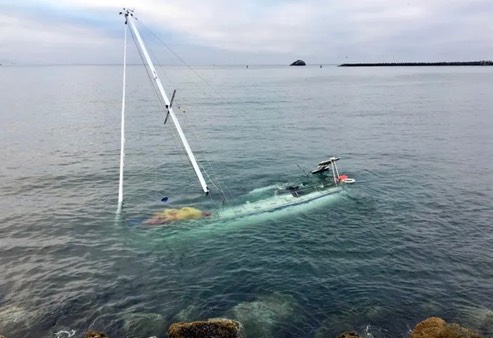
Chasing leaks on boats is a time-honored obsession. Rule number one in all galaxies of the nautical universe through all of nautical history has always been the same: keep the water on the outside.
Charles Doane gives us a new example of the term “status quo”:
[O]wners of planked wooden boats take the business of pumping the bilge for granted and nonchalantly track the health of their hulls by counting how many strokes a day it takes to keep everything above water. As long as the number isn’t rising, they figure all is well.
It can be a challenge!
/fl
Weather
Aftermath of Hurricane Dorian

Marsh Harbor, Abacos, Bahamas following Hurricane Dorian.
Aerial photo’s can't convey the in-depth magnitude of this storm; you need to be on the ground, in the rubble, to grasp that overwhelming feeling of helplessness. You can get an idea of what it is like, by the demeanor of this reporter:
The United States Coast Guard was hard at work strategically staging resources prior to Dorian’s arrival in the Bahama’s, and following the storm’s passage they have been working around the clock rescuing and relocating victims. Due to the magnitude of this storm, it’s going to take weeks of tireless effort.
Semper Paratus!
/fl
Marksmanship: Safety
Semi-Automatic Tech: Understanding Chambers
by Glen Zediker
Important to note: These “warnings” have been around for years, but they’re still not always heeded—or understood (related).
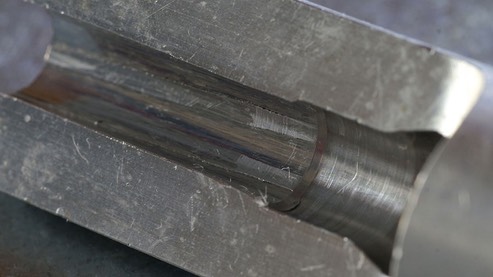
The impetus for this article came from a recent experience at a local gun shop. I went there in search of a subsonic .300 Blackout load, and they had one in .300 Whisper. The counterperson had told me that it was “exactly the same as .300 Blackout, just like .223 Rem. is the same as 5.56 NATO.” Neither statement was true, although Whisper specs are plenty close enough to Blackout that no differences factor in regarding safety or function. However, .223 Rem. and 5.56 NATO are not nearly the same.

Hornady Black 5.56 NATO 62-grain FMJ.
The difference is pressure.
There can be minute but measurable differences in any single dimension (neck diameter, headspace, case length, cartridge length) from brand to brand, commercial or mil-spec, but there is no defining, critical difference in .223 Rem. and 5.56 NATO cartridge dimensions. I see folks on forums worried that they can’t find reloading dies for it. They don’t exist. Now, chamber headspace gauges are different because of the chamber specs. Again, not because of the cartridge specs. That matters to DIY builders. Minimum dimensions are the same, but NATO specs allow a longer maximum figure to still be within spec.
Some definitions: SAAMI and NATO
SAAMI (Sporting Arms and Ammunition Manufacturer’s Institute) is a voluntarily given information base that defines our modern centerfire-cartridge specifications; manufacturers tend to agree. SAAMI defines minimum and maximum headspace, for instance, and also chamber pressure maximums.
NATO (North Atlantic Treaty Organization) standardized ammunition is used by the Allies, including U.S. Armed Forces. It has its own set of standards for dimensions and outputs.
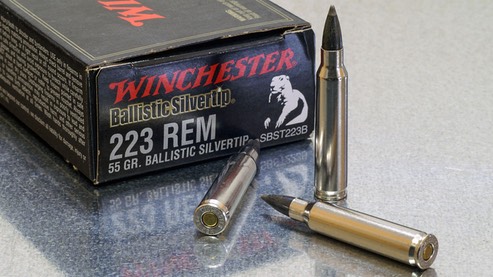
Commercial .223 Rem. ammo is marked as what it is. This is safe in either chamber.
Which, How, Why?
Here’s where .223 Rem. and 5.56 NATO came from, and largely where the differences originated. First, there was the .222 Rem. This was uniquely developed (no parent case) in 1950 as a cartridge for varmint hunting. It was the first commercial rimless .224 cartridge made in the USA. So, when Armalite, and others, started its Small-Caliber/High-Velocity (SCHV) experiments, this is what they started with. It was clear early on that it would not meet the Continental Army Command (CONARC) velocity and penetration requirements, so Armalite went straight to Remington. Remington in turn created the .222 Remington Special, which had a longer case body and shorter case neck than .222 Rem.—adding capacity. In 1963, the Remington .222 Special got its designation as 5.56x45mm and was officially adopted for use in the new M16 rifle (which was actually already in use). The next year it got its full commercial SAAMI specs and emerged as .223 Rem. in commercial loadings.
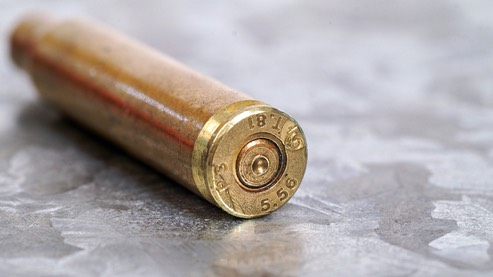
Here’s what happens when putting a factory-fresh NATO round through a .223 Rem. chamber. This case is clearly beat. Sure, it held up for that firing, but this case is not reusable.
On the commercial market, .223 Rem. sought to find its place as a
varminting round. That is the short-answer reason how .223 Rem. and
5.56 NATO ended up with different chambering specs and pressure limits.
The first commercially available rifle in the new .223 Rem. was a
Remington Model 760 Gamemaster pump-action. Not exactly an AR-15.
For better performance with the common and popular 50- to 55-grain varmint bullets, and also following along with the norms at the time for chambering bolt-action rifles commonly used for varmint hunting, the SAAMI-spec .223 Rem. has a fairly short leade in the chamber throat. It remains that way to this day. The leade in a NATO-spec 5.56 is radically longer.
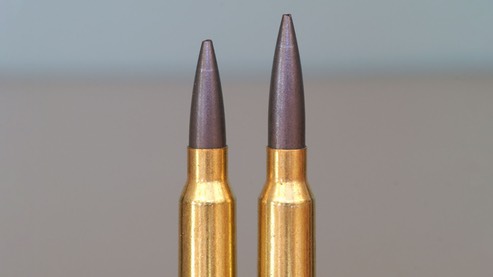
This is the effect of leade length and angle. These two cartridges contain a Sierra 80-grain MatchKing seated to touch the lands. Left: SAAMI, right: NATO. There’s a whopping 0.150-inch difference.
Tech: Leade, a.k.a. “freebore” is the space
between the end of the case-neck portion of a rifle chamber and the
first point forward from which a bullet would contact the lands or
rifling in the bore. It’s kind of like a funnel. A longer space (a
bigger gap) increases the volume available to accept high-pressure
propellant gases at this critical point where cartridge pressure is
highest. NATO is radically more generous. It’s longer, with more volume
(the actual difference in the reamers is SAAMI equals .0250 inches and
NATO is .0566 inches). NATO gives relatively much more room for
expanding gases to occupy.
Don’t underestimate gas pressure in action folks. There can be a solid 10,000 PSI difference comparing the same ammo run through a SAAMI- and a NATO-spec chamber. That’s the equivalent of more than a full grain of propellant in the case—that’s a lot.
First point: Never fire NATO-spec ammo in a .223 Remington chamber. It will be, not may be, over-pressure. A barrel with a NATO chamber will have a “5.56” stamp on it, or, hopefully, a more-complete designation and include “NATO,” but I have increasingly seen barrels that aren’t stamped at all.
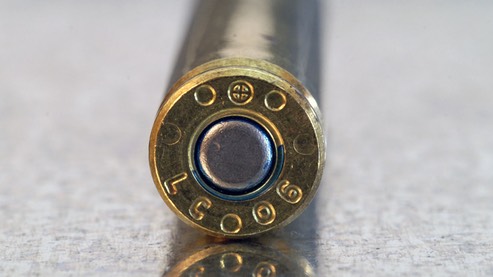
The cross-in-a-circle stamp identifies this as a genuine NATO-spec cartridge. It’s hot and getting hotter. Not all “mil-spec” commercially available ammo is genuine NATO, but don’t risk it. It needs to be stamped “.223 Rem.”
If you’re shopping barrels to do it yourself, or a gun to
purchase, I recommend choosing a NATO chamber, if there’s an option—and
that’s because then you have an option in ammo. Tips and hints: the
SAAMI-spec .223 Rem. chamber is often also called a “match chamber” or
sometimes a “minimum” chamber.
What’s a “Wylde?”
To throw another option into the mix, there’s also the “Wylde” chamber. It is popular and available—especially in aftermarket barrels.
Bill Wylde was one of the original AR-15-accuracy pioneers and focused on building guns for use in NRA High Power Rifle. When the longer, heavier .224-cal. match bullets showed up, like the Sierra 80-grain MatchKing, which cannot be seated deeply enough to fit into the magazine box, Wylde designed his own chamber reamer. The idea was to give additional length (compared to SAAMI spec) in the leade to accommodate these bullets, but also to compromise between the SAAMI and NATO spec with the idea of shortening the “jump” to engage the lands for the 69- to 77-grain bullets that were fed from the magazine. It’s in-between SAAMI and NATO.
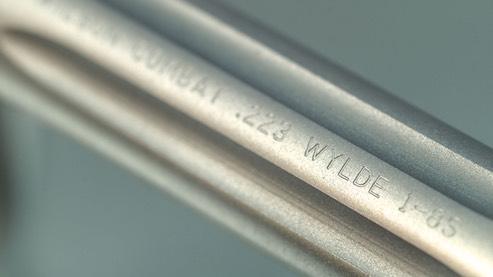
A Wylde might be the best overall, because it’s a compromise with no real downsides. It takes higher pressure and shoots well.
The best accuracy for magazine-length .223 Rem. commercial-spec
rounds still may come from a SAAMI spec, and that’s because it offers
the shortest jump into the lands. Exploiting that has everything to do
with bullet choice (ogive dimensions). Rumors are true—it is safe to
fire NATO-spec ammo through a Wylde, although a NATO still means lower
pressure.
So, a Wylde is a good compromise, as it was originally intended to be, because it gives us the choice of firing genuine NATO and the potential for better on-target performance. I say “potential” because you can’t prove it by me. I had a Colt’s-brand HBAR barrel (NATO chamber) once in an NRA Service Rifle that shot such a ton of clean rapid-fire event scores for me that I can’t say NATO won’t shoot. Right. I got lucky (and it further proves that any barrel can be good). I also think that once bullet jump gets more than a scant few thousandths of inches, the leade angle (not so much length) matters more for good accuracy. There are slight differences in NATO reamers, but the most common cuts a shallow 1.2-degree leade-in angle (one way to get the extra-long throat)—and that is gentle—eases bullet entry into the lands. A SAAMI spec calls for a 3.2-degree transition. Wylde is 1.25-degrees, so likewise smooth.
Pressures Defined, and Redefined
Let’s get some more numbers out here. NATO ammo is hot, and getting hotter. Over a few years, .223 Rem. commercial has pumped up also. Overall, pressures have increased in many cartridges, both rifle and handgun.
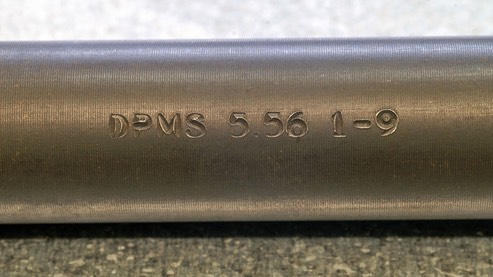
Your barrel might be marked “5.56” and that means “NATO.” If it’s “.223 Rem.” do not fire NATO through it. If your barrel isn’t marked—get it checked.
That’s leading to this: I am the proud and
privileged owner of an URG-I, which is the very latest (2018) USASOC
contract M4 (I have the upper, not the lower). This is a big change from
previous configurations, and the changes pretty much revolve around
increasing its capacity to handle cartridge pressure. I opened up a few
boxes of “genuine” NATO 5.56mm to check it out, something I honestly
haven’t fired for years. Dang, that stuff is potent. Over the past
several years, the pressure level has increased. As best I could
authenticate, it was 55,000 PSI back at the start. Current standard is a
little over 62,000 PSI. (NATO is technically measured differently than
SAAMI, but the figures I give here are accurate for comparison.)
Compared to current SAAMI specs for .223 Rem. that’s a solid +7,000
difference (again, it can be up to +10,000 depending on the load). As
said, that SAAMI-spec figure has also increased over the years; original
.223 Rem. specs called for max at 52,000 PSI, and that’s still a common
max listed in loading data.
There’s a reason behind this story: That gun would not function with commercial .223 Rem. The very newest NATO—M855A1 (AB57)—is said to be up to 65,000 PSI. Dang. That is what it was built around. I suspect it’s the short 14.5-inch barrel that’s at the heart of continually ramping up 5.56 NATO velocity, but they didn’t ask me.
For Handloaders
This is important: First, just because it can “take it” doesn’t mean you have to give it out. You do not need to load NATO-level for use in a NATO chamber. There’s more to that, or can be, as my little URG-I story told. If it’s an AR-15, especially a carbine (any with a shorter gas-system length than rifle-standard), you need to load to an adequate pressure level for good function. That level can be variable, and function tuning is easily possible (different buffers, springs, adjustable gas systems). Getting to the point: I recommend using .223 Rem. load data, even if it’s on the upper end. NATO-level loading shortens case life and needlessly hammers the gun. Folks, soldiers don’t pick up their brass. NATO is only ever intended to be fired once.
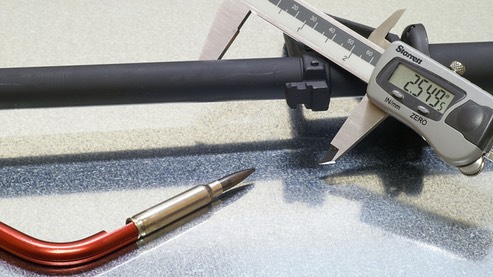
This Hornady LNL Overall Length Gauge is designed to show the bullet seating depth that touches the lands with a particular bullet.
Also, pay attention to the test barrel specifications when
researching load data. What is the barrel length and, above all, which
chamber? Keep the differences in mind when interpolating the data
listed. If there’s a “max” load and it’s tested in a NATO chamber,
(Colt’s HBAR for instance) you best not start close to that if you’ve
got a SAAMI chamber.
The preceding is a specially-adapted excerpt from Glen’s books Top-Grade Ammo and America’s Gun: The Practical AR15. Visit zediker.com for more information plus downloads from Zediker Publishing.
Sources
- Hornady
800-338-3220
Hornady.com - Forster Products
815-493-6360
ForsterProducts.com - Sierra Bullets
888-223-3006
SierraBullets.com - URG-I
Geissele Automatics
610-272-2060
Geissele.com
/Reprinted from Shooting Sports USA
Weather
Hurricane Dorian
An 09/03/19 aerial survey of Dorian’s damage in the Bahama’s:
The wind force is illustrated by the damage to this new concrete construction. The reinforced concrete cap, designed to keep the walls intact, failed; probably due to the fact that there was nothing keeping the wind outside the building. The exact location of this building is unknown.
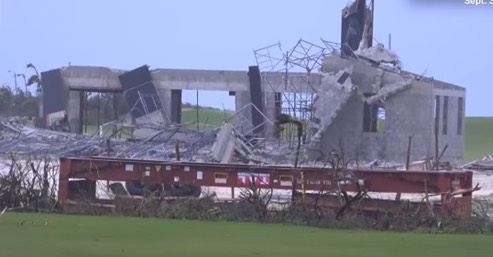
Evidently the most wind damage to Grand Bahama Island occurred on the North Shore of the island, although I have not seen any pattern comparison yet. The surge evidently swept the entire island.
A monster storm!
/fl
Weather
Hurricane Dorian
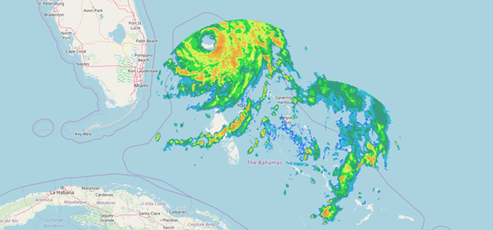
Satellite and radar imagery show that Dorian is moving very slowly over Grand Bahama Island this morning...A prolonged period of catastrophic winds and storm surge will continue to affect Grand Bahama Island through today and tonight...Dorian is forecast to remain a very powerful hurricane while it moves near the southeastern United States coast...The hurricane is expected to drift westward or west-northwestward over the next 24 hours, which will cause a prolonged period of devastating winds and storm surge over Grand Bahama Island. By late Tuesday, the weakness in the ridge becomes more pronounced and Dorian should turn northwestward near the east coast of the Florida. By day 3, the hurricane is expected to make a northeastward turn ahead of a broad mid-latitude trough. The overall track envelope has not changed much, and little adjustment to the previous NHC forecast was required...It cannot be stressed enough that only a small deviation to the left of the NHC forecast could bring the core of the extremely dangerous hurricane onshore of the Florida east coast within the hurricane warning area. In addition, Dorian's wind field is predicted to expand, which would bring hurricane-force winds closer to the east coast of Florida...Life-threatening storm surge and dangerous hurricane-force winds are expected along portions of the Florida east coast and Georgia coast, regardless of the exact track of Dorian's center.
Triple digit (100-155 mph) wind speeds are forecast through the next four days as hurricane dorian grinds away. It still looks like the center of the eye will be tracking offshore in or near the Gulf Stream.
Source: NOAA & Bahamas Radar
But wait, there’s more!
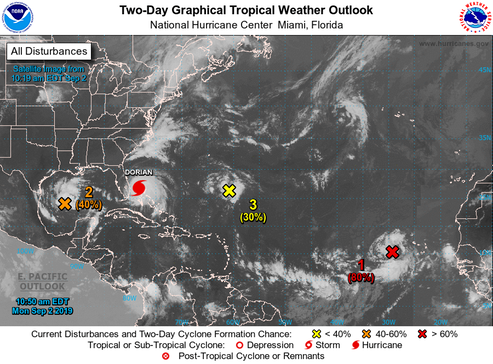
/fl
Weather
Bahamas taking horrific direct hit from intense Category 5 Hurricane Dorian
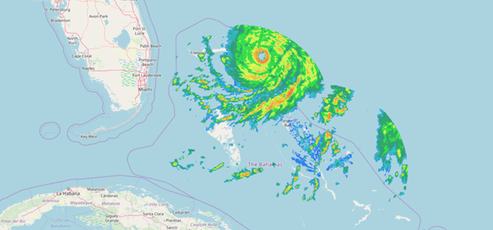
For some, the experience could be like enduring an hours-long tornado!
“This is a life-threatening situation.”
Abaco’s largest community is Marsh Harbor. The town of 6,000 people sits 13 feet above sea level, making them vulnerable to a surge of the magnitude currently forecast… The Hurricane Center warned of wind gusts over 200 mph and storm-surge flooding of 15 to 20 feet above normal tide levels.
If you have ever been to Grand Bahama Island or the Abaco’s, you understand the magnitude and potential of this!
Prayers for those in the path of this storm.
/fl
